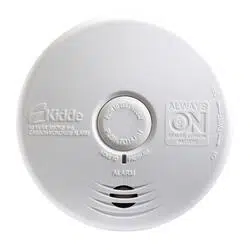Loading ...
Loading ...
Loading ...

is not burning completely and may be releasing CO. Teach all household members
what the alarm sounds like and how to respond. Fire Departments, most utility
companies and HVAC contractors will perform CO inspections, some may charge
for this service. It’s advisable to inquire about any applicable fees prior to having
the service performed. Kidde will not pay for, or reimburse the owner or user of
this product, for any repair or dispatch calls related to the alarm sounding.
SYMPTOMS OF CO POISONING
Initial carbon monoxide poisoning symptoms are similar to the flu with no fever
and can include dizziness, severe headaches, nausea, vomiting and disorienta-
tion. Everyone is susceptible but experts agree that unborn babies, pregnant
women, senior citizens and people with heart or respiratory problems are espe-
cially vulnerable. If symptoms of carbon monoxide poisoning are experienced
seek medical attention immediately. CO poisoning can be determined by a car-
boxyhemoglobin test.
The following symptoms are related to CARBON MONOXIDE POISONING and
should be discussed with ALL members of the household:
1. Mild Exposure: Slight headache, nausea, vomiting, fatigue (often described
as “Flu-like” symptoms).
2. Medium Exposure: Severe throbbing headache, drowsiness, confusion,
fast heart rate.
3. Extreme Exposure: Unconsciousness, convulsions, cardio respiratory
failure and death.
The above levels of exposure relate to healthy adults. Levels differ for those
at high risk. Exposure to high levels of carbon monoxide can be fatal or cause
permanent damage and disabilities. Many cases of reported carbon monoxide
poisoning indicate that while victims are aware they are not feeling well, they
become so disoriented they are unable to save themselves by either exiting the
building, or calling for assistance. Also, young children and household pets may
be the first effected. Familiarization with the effects of each level is important.
11. CLEANING YOUR ALARM
YOUR ALARM SHOULD BE CLEANED AT LEAST ONCE A YEAR
You can clean the interior of your alarm (sensing chamber) by using compressed
air or a vacuum cleaner hose and blowing or vacuuming through the openings
around the perimeter of the alarm. The outside of the alarm can be wiped with
a damp cloth. Use only water to dampen the cloth, use of detergents or clean-
ers could damage the alarm.
Loading ...
Loading ...
Loading ...
